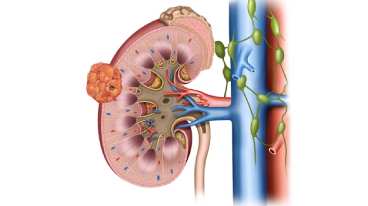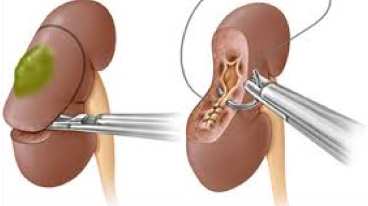Partial Nephrectomy or Nephron Sparing Surgery (NSS) in Kidney Cancer Treatment: What, When, Why - Current Perspective and Future Trends
Introduction
Kidney cancer, or renal cell carcinoma (RCC), is a significant health burden and one of the most common urological cancer in the world that requires precise and effective treatment strategies. Radical Nephrectomy or removal of entire kidney has been the cornerstone of kidney cancer treatment in the 20th century. However as more and more patients are getting diagnosed with small renal masses, it is possible to spare the kidney by various modalities. One such surgical treatment of small renal masses or kidney cancer is Partial Nephrectomy, also known as Nephron Sparing Surgery (NSS). This surgical approach aims to remove the cancerous part of the kidney while preserving as much healthy tissue as possible. This comprehensive blog will explore what is partial nephrectomy, when and why it is used, the current perspectives, and future trends in this vital area of kidney cancer treatment in India. We'll also delve into the different surgical techniques, including open, laparoscopic, and robotic surgery.
What is Partial Nephrectomy or Nephron Sparing Surgery (NSS)?
Understanding the NSS Surgery
Partial nephrectomy, or nephron-sparing surgery (NSS), involves the removal of a kidney cancer while preserving the remaining healthy kidney tissue. This procedure is particularly beneficial for patients with small, localized tumors or those who have only one functional kidney. The goal is to eradicate cancer while maintaining as much kidney function as possible, reducing the long term risk of chronic kidney disease and the need for dialysis in kidney cancer patients.
Techniques in Partial Nephrectomy

Open Partial Nephrectomy :
Open partial nephrectomy is the traditional approach, where a surgeon makes a large incision to access the kidney. This method provides direct visualization and access to the tumor, making it suitable for complex cases. While it offers excellent outcomes, the recovery time can be longer due to the invasiveness of the procedure.

Laparoscopic Partial Nephrectomy
Laparoscopic partial nephrectomy is a minimally invasive technique that uses small incisions and specialized instruments. This method offers the benefits of reduced pain, shorter hospital stays, and quicker recovery times. However, it requires a high level of surgical expertise by a urologist oncologist and is generally used for smaller, less complex kidney tumors.

Robotic-Assisted Partial Nephrectomy
Robotic-assisted partial nephrectomy combines the benefits of laparoscopic surgery with the precision of robotic technology. The surgeon controls robotic instruments, providing enhanced dexterity and visualization. This technique allows for precise tumor removal and suturing, making it suitable for a broader range of patients. It also offers the advantages of minimal invasiveness, reduced blood loss, and faster recovery.
When is Partial Nephrectomy Used?
Indications for Partial Nephrectomy
Partial nephrectomy is indicated for patients with :
- Small, localized renal tumors (typically less than 4 cm in diameter)
- Bilateral kidney tumors or tumors in a solitary kidney
- Pre-existing chronic kidney disease or conditions that increase the risk of kidney failure
- Patients who are candidates for kidney-sparing surgery based on tumor size, location, and overall health
Timing and Decision-Making
The urooncologist will decide to perform a partial nephrectomy depending on several factors, including tumor characteristics, patient health, and the potential for preserving kidney function. Early-stage kidney cancer, where the tumor is confined to the kidney, is the ideal scenario for partial nephrectomy. However, advancements in surgical techniques and experience of the robotic surgeon have expanded the indications to include more complex cases.
Why is Partial Nephrectomy Important?
Benefits of Nephron-Sparing Surgery
Preservation of Kidney Function
The primary advantage of partial nephrectomy is the preservation of kidney function. By sparing healthy kidney tissue, patients maintain better renal function, reducing the risk of chronic kidney disease and the need for dialysis in the future.
Reduced Complications
Partial nephrectomy is associated with fewer complications compared to radical nephrectomy, where the entire kidney is removed. Preserving kidney tissue helps in maintaining electrolyte balance, blood pressure regulation, and overall metabolic health.
Improved Quality of Life
Patients undergoing partial nephrectomy typically experience a better quality of life post-surgery due to preserved kidney function, faster recovery times, and fewer long-term health issues associated with kidney removal.
Oncological Outcomes
Partial nephrectomy offers excellent oncological outcomes for small, localized tumors. Studies have shown that cancer control rates are comparable to those of radical nephrectomy, making it a viable option for early-stage kidney cancer.
Current Perspective on Partial Nephrectomy
Clinical Adoption and Guidelines
Partial nephrectomy has become the standard of care for small renal tumors, with numerous studies supporting its efficacy and safety. Guidelines from leading organizations, such as the American Urological Association (AUA) and the European Association of Urology (EAU), recommend partial nephrectomy as the preferred treatment for T1a renal tumors.
Advances in Surgical Techniques
The evolution of surgical techniques has significantly improved the outcomes of partial nephrectomy. The introduction of laparoscopic and robotic-assisted techniques has reduced the invasiveness of the procedure, allowing more patients to benefit from nephron-sparing surgery. Robotic Surgeons and urooncologists are now able to tackle more complex kidney tumors with greater precision, further expanding the indications for partial nephrectomy.
Research and Innovations
Ongoing research and innovations continue to enhance the field of nephron-sparing surgery. Studies are focusing on refining robotic surgical techniques, improving imaging methods for better kidney cancer localization, and developing new technologies to assist in tumor removal and reconstruction of the kidney. These advancements aim to improve surgical outcomes and extend the benefits of robotic partial nephrectomy to a broader range of patients.
Future Trends in Partial Nephrectomy
Integration of Advanced Imaging Techniques
Advanced imaging techniques, such as three-dimensional (3D) imaging and intraoperative ultrasound, are playing an increasingly important role in partial nephrectomy. These technologies provide detailed visualization of the tumor and surrounding structures, aiding in precise tumor localization and minimizing damage to healthy kidney tissue.
Artificial Intelligence and Machine Learning
Artificial intelligence (AI) and machine learning are poised to revolutionize robotic partial nephrectomy by enhancing preoperative planning, intraoperative decision-making, and postoperative assessment. AI algorithms can analyze imaging data to predict kidney cancer behavior, guide surgical approaches, and optimize patient outcomes.
Personalized Medicine
The future of partial nephrectomy lies in personalized medicine, where treatment strategies are tailored by urologist oncologist to individual patients based on their genetic makeup, tumor characteristics, and overall health. Advances in genomics and molecular biology are paving the way for personalized approaches that maximize the benefits of nephron-sparing surgery.
Robotic and Minimally Invasive Techniques
Robotic and minimally invasive techniques will continue to evolve, offering greater precision, reduced invasiveness, and improved patient outcomes. The development of next-generation robotic systems with enhanced capabilities will further expand the adoption of partial nephrectomy by urooncologists, making it accessible to more kidney cancer patients.
Telemedicine and Remote Surgery
The integration of telemedicine and remote surgery is another exciting trend in the field. Experienced Urooncologist and Robotic Surgeons at high volume centres in world can now collaborate with urologist surgeons in remote areas and perform complex procedures remotely, leveraging robotic systems and advanced communication technologies. This approach has the potential to bring expert urooncologist care to underserved regions and improve access to nephron-sparing surgery.
Conclusion
Robotic Partial nephrectomy, or nephron-sparing surgery, has emerged as a cornerstone in the treatment of kidney cancer in India, offering significant benefits in terms of preserving kidney function, reducing complications, and improving quality of life. The evolution of surgical techniques, particularly robotic surgery in India, has expanded the indications for this procedure and enhanced its outcomes.
As we look to the future, advancements in imaging, artificial intelligence, personalized medicine, and robotic technology will continue to shape the field of Robotic partial nephrectomy in India. These innovations hold the promise of further improving patient outcomes, expanding access to nephron-sparing surgery, and advancing our understanding of kidney cancer.
If you or a loved one is facing kidney cancer, discussing the option of partial nephrectomy and Robotic Surgery with your urologist oncologist could be a critical step in your treatment journey. Early and accurate detection, combined with personalized treatment strategies, can significantly enhance the chances of successful outcomes and improved quality of life.
This detailed blog aims to provide an extensive understanding of best treatment of kidney cancer and partial nephrectomy and Robotic Surgery in India; its importance, current perspectives, and future trends.

